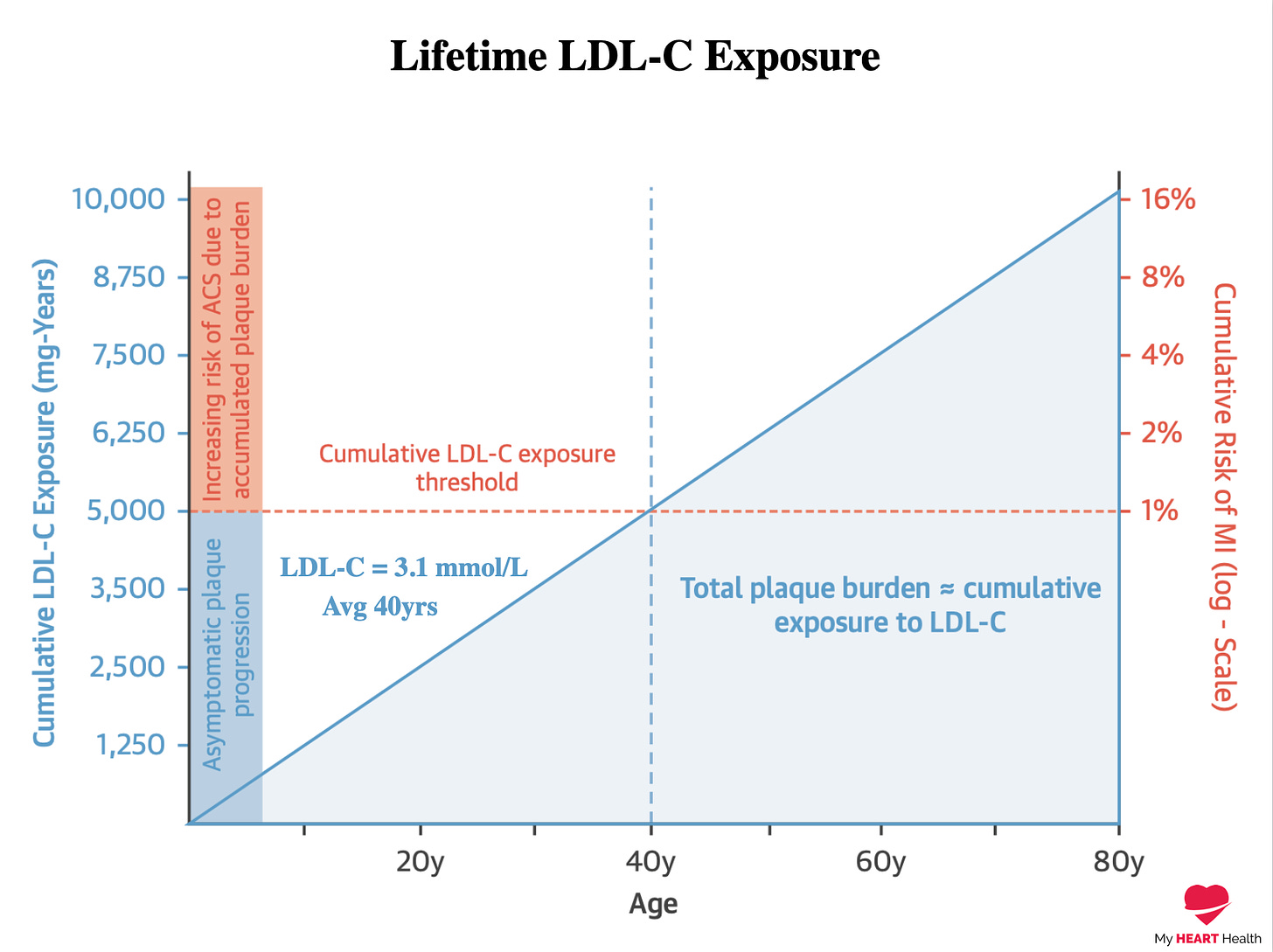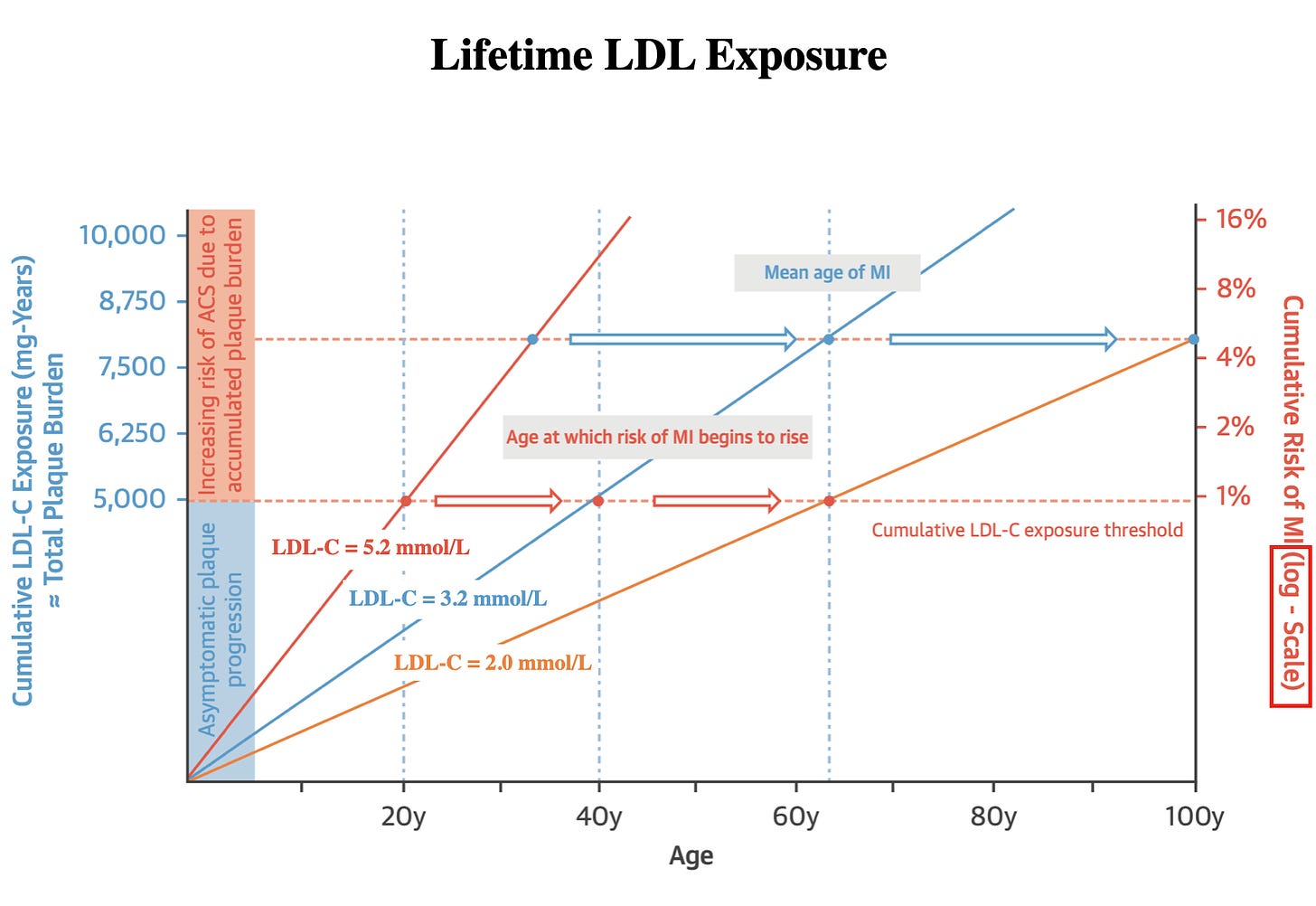How To Think About High Cholesterol

Most guidelines assessing cardiovascular risk use a ten-year time frame to estimate the risk of a heart attack or death. This level of risk then defines who should receive cholesterol-lowering therapy.
This risk of heart attack or death is, of course, what patients understandably worry about the most. They worry much less about whether they have high cholesterol or plaque in their arteries.
In my view, a ten-year time horizon is helpful only if you expect to live another ten years. But if you plan on living longer than another ten years, you might want to think about things a little differently.
Cardiovascular disease is a leading cause of death, accounting for 35% of all deaths in the developed world. The majority of these deaths are a result of the complications of coronary artery disease, also known as atherosclerosis.
Atherosclerosis is more commonly referred to as ‘plaque’ in the artery wall. (The terms atherosclerosis and plaque will be used interchangeably.)
Atherosclerosis is caused by the retention of cholesterol particles in the arterial wall.
Simple as that.
Of course, this process has significant complexity, but at its core, a cholesterol particle is retained in the artery wall.

This retained particle initiates an inflammatory process and, over time, results in the progressive build-up of atherosclerosis in the coronary arteries.
The more atherosclerosis, the greater the risk a plaque ruptures, causing a heart attack.
More Plaque = More Risk.
The total plaque burden is a function of 2 parts:
-
The number of cholesterol particles the artery wall is exposed to
-
Time
Therefore:
Total Plaque Burden = Cholesterol Exposure X Time.
Although atherosclerosis accumulates in our artery walls from very early in life (Discussed previously here), the likelihood of having a heart attack early in life is low.
The cumulative incidence of heart attacks for 40-year-olds is about 1%. Therefore, on average, by age 40, the total plaque burden/cholesterol exposure must have reached a sufficient threshold to increase the risk of a heart attack to a significant degree.
Therefore:
The Total Plaque Burden needed for a 1% Risk of a Heart Attack = Average Cholesterol X 40 years.
So what is the value we are trying to solve for?
The answer is 125mmol/l years which is approximately 40 years of having an LDL of 3.1mmol/l. This is the average LDL cholesterol for adults in most populations. Remember, we are referring to LDL cholesterol, not Total Cholesterol, which you also see reported on your lab test. Our US counterparts' total LDL cholesterol exposure number is 5000mg/dl - 125mg/dl for 40 years.
Said simply. Having an LDL cholesterol of 3.1 mmol/l for 40 years results in a sufficient amount of atherosclerosis to give you a 1% risk of a heart attack.
What is crucial to understand is that cholesterol exposure increases linearly over time. For example, at 50 years, with an average LDL-C of 3.1 mmol/l total exposure is 155 mmol/l; by 60, it is 186 mmol/l and so on.
However, the risk of having a heart attack increases exponentially.
What was a 1% risk at age 40 is a 2% risk at age 50, a 4% risk at age 60 and an 8% risk by 70. Crossing this 125mmol/l total cholesterol exposure threshold then comes with exponentially increasing risk for the same amount of cholesterol exposure over time.

The above graph shows a hypothetical individual with a cumulative total cholesterol exposure of 125mmol/l years (5000mg/dl years) by age 40 with a 1% risk of a heart attack. The shaded blue area illustrates the total amount of plaque accumulated to result in a 1% risk of a heart attack.
At this point, we need to consider using a ten-year risk estimation on our hypothetical 40-year-old patient. Assuming they are nonsmokers with relatively normal blood pressure, their ten-year risk of an event is approximately 2%. While most guidelines suggest continuing lifestyle measures or to ‘consider’ drug therapy, in practice, most patients will not be commenced on lipid-lowering treatment. Instead, patients will likely be continually re-evaluated until their risk exceeds a set threshold and drug therapy is commenced.
As time passes, our now likely 50 to 60-year-old patient will have accumulated a substantial extra burden of plaque in their arteries and also be exposed to an exponential increase in their risk of a heart attack.
How do we minimise risk, then?
If Risk = Total Cholesterol Exposure X Time, there is only one variable we can change: total cholesterol exposure. How I wish we could modify time.

As the graph above illustrates, with an average LDL-C of 2.0 mmol/l, the 1% risk threshold has now been pushed out into the patients’ early 60’s compared to age 40, when LDL-C was on average 3.1 mmol/l. The average age of having a heart attack has now moved from mid 60’s to 100 years of age. Conversely, if the patient’s average LDL-C is 5.2mmol/l, the 1% risk threshold is met at age 20. This is why early and aggressive management of Familial Hyperlipidemia (FH) is so important.
As discussed in previous posts, atherosclerosis is a chronic progressive condition that starts early in life and is a certainty for everyone who lives long enough. The goal then is not to prevent atherosclerosis but to delay the build-up for as long as possible, so one lives with the smallest plaque burden possible for the longest time possible.
More Plaque = More Risk
Less Plaque = Less Risk
Lowering Cholesterol
The optimal way to lower one’s cholesterol exposure is through lifestyle measures. This approach means that the additional benefits of regular exercise and good nutrition, for example, are also accrued, and there is no potential for adverse drug reactions.
In reality, few people can sustain the lifestyle measures for long enough periods to achieve their optimal LDL-C. Furthermore, even the best lifestyle approaches may not be sufficient to reach an optimal target LDL-C.
It is at this point we must consider medications to lower cholesterol. There are many, but the primary choice is statin therapy. Current guidelines for statin therapy use rely on a patient exceeding a specific ten-year risk of a heart attack. But I hope that you can see the fallacy of such an approach by now.
The goal should be to lower LDL cholesterol long before a person reaches that risk threshold that is traditionally used. The 10-year risk strategy is, in my view, a fundamentally flawed approach to thinking about when cholesterol should be lowered with drug therapy.
This is not to suggest that everyone go on drug therapy for their entire lives. But everyone should be at least given the choice if they have an LDL cholesterol that is not optimal for their level of risk tolerance.
So the next time you meet with your doctor because your cholesterol level is too high, ask yourself what your goal is? And also, understand that clinicians often make decisions based on guidelines that emphasise waiting for risk to accumulate rather than preventing it.
In the end, it is you who assumes the risk. Not the doctor.
As my flying instructor used to say about taking possibly unsafe instructions from Air Traffic Control - “If you fly into something because of what they say, it’s going to hurt you a lot more than it’s going to hurt them”.
When it comes to your health, you are the pilot in command.
You call the shots.




